|
Everything dies baby that’s a fact
But maybe everything that dies someday comes back --Atlantic City, Bruce Springsteen It’s mid-March, the weather is miserable, and the Big East is in the Garden. This was the best basketball conference that ever was, because it was Big and because it was East – players and fans, bundled up, road salt on their shoes, with a case of the sniffles, playing in the most noted basketball arena in the land. Ewing of Georgetown. Mullin of St. John’s. Pinckney of Villanova. They all went to the Final Four one year. We know the names of the defectors who joined football conferences, putting their students out of reasonable driving range for road games, teaching the great lesson of college sports, which is screw loyalty, screw history. Go for the money. Somehow the Big East stays alive with 10 teams, some of which I could not name -- 10 colleges that cannot afford legions of football players on their campus. All I know is that St. John’s and Georgetown and Villanova and Providence and Seton Hall are still around. I smiled at the photo in the Times of Val Ackerman, the new president of the newly-configured league, sitting in an empty league office. It was her statement: The league of Looie’s garish sweaters and Big John’s style statement is still intact.
Brian Savin
3/13/2014 10:07:59 am
Amen, good Brother!! It sure didn't take you very many sentences to cut right to the good, and increasingly bad, of college sports. Thanks for this.
Ed Martin
3/13/2014 03:57:53 pm
Became a St. John's fan in the 80's and saw many games on campus and in the Garden. What a parade of talent, Mullen, Jackson, Berry: Ewing and Co.; Pearl Washington and the Orangemen, etc.etc. etc.
Sam Toperoff
3/13/2014 11:11:09 pm
Here's why I read this blog every day--the writing:
George Vecsey
3/14/2014 02:20:37 am
Sam, thanks. This really is my therapy web site -- as much fun as playing basketball alone in the schoolyard. One could be (this dates me) Cousy and McGuire at the same time.
Ed Martin
3/14/2014 09:56:21 am
My therapy website, too. My own, primarily about Venice Florida government and politics, (leavened by some popular culture) is a kind of therapy too, although it causes a release of Adrenaline from time to time in frustration. The " Cooz" and tricky Dick were every kids role models. In 1944 a "Cinderella Team," Utah won the NIT, the tournament, led by Arnie Ferrin and Vern Gardner. Ferrin's game-winning shot began as a fake hook to his left. As the fellow guarding him moved to the fake, Ferrin reversed and laid up an underhand shot off the backboard for the win. We practiced that shot for ours on our dirt lot, one basket "Garden."
George Vecsey
3/14/2014 10:40:48 am
Ed: Also on that team was Wat Misaka, who later played briefly for the Knicks, and was honored in 2009...I got to walk into the Garden with him, and he saw his name on a team plaque near the clubhouse.
Ed martin
3/14/2014 04:01:15 pm
Really enjoyed the Misaka story---prototype GV, humanity, history, sports and literature.
GV and friends, apologies for frequent comments. I found my 70 year old memory was slightly off. from NCAA
George Vecsey
3/15/2014 01:51:53 am
Ed, thanks for the great comments.
Brian Savin
3/15/2014 02:06:00 am
Today is so different, isn't it? Buffett will give us a billion bucks if we can figure out a way to shave points for only a few score games this month. There's probably enough there to do it and still have enough left over for this entire blog to party in Bimini.
George Vecsey
3/15/2014 03:09:33 am
Buffett? College basketball?
Ed Martin
3/15/2014 03:24:01 am
Although my inner "Archie Bunker" told me to "stifle myself," your mention of 1949 NIT was too much temptation. I was a freshman at tiny Muhlenberg College,which, led by a fine player Harry Donovan, played the NY teams. In 49 CCNY beat 'Berg 95-76. Went on to win NIT and NCAA. CCNY had two Black and three Jewish 3/16/2014 01:50:12 pm
Good stuff about college basketball’s golden age in its Mecca, the metro NY area. The period from the mid-1940’s to the early 1950’s was an exciting time for a teenager to follow basketball. There was a mass exit of players and coaches after the 1950 point shaving scandal, mainly to the south where Al and Frank Maguire set up. It was not until the rise of the Big East that basketball again became respectable in our area.
Ed Martin
3/16/2014 04:22:17 pm
Thanks Alan, while it was the 49-50 season, I wrote just the 49. Berg played a tough schedule in those years, CCNY, LIU, St. johns, Seton Hall and from Philly, Villanova, LaSalle, Temple, St Joes and Penn. Stars included The CCNY gang, Sherman White, Eddie Guard, Walter Dukes, Paul Arizin, Jerry West, Bill Mlkvy (the Owl without a vowel), little Pete Carrill from Lafayette and I think Lehigh had a team.
Mike from Whitestone
3/16/2014 04:27:49 pm
Thanks GV for the visit back in time with the Big East and March. My best friend and I would take vacations this week and be at every game in the mid 80's, day/night, two double-headers, whatever, we were there.
George Vecsey
3/17/2014 01:59:16 am
As the holder of an Irish passport, I will stay indoors today and play Loreena McKennitt and the Chieftains. 3/17/2014 05:22:23 am
Gearge
George Vecsey
3/17/2014 06:41:17 am
Alan, thanks. Will check it out. One daughter and husband are going on a Larry Kirwan music tour of Ireland in October -- best bands, best pubs. 3/17/2014 07:04:01 am
My son and his wife visited Ireland several years ago. Every pub and public drinking place had some form of music every evening. Comments are closed.
|
Categories
All
|










